About Herbaceous Peonies
A Beautiful and Beloved Garden Classic
Longevity and Beauty
An of Array Color, Form and Plant Habit

Herbaceous Hybrid ‘Roselette’
Herbaceous peonies are one of the most easily grown hardy perennials available today. Long lived and durable, a peony can easily live as long as 100+ years.
As a herbaceous perennial, this group of peonies produces annual stem growth during the spring and summer, only to die to the ground in late fall and remain dormant through the winter season. The large fleshy root systems, crown and buds come to life again each spring to produce the flowers we have come to admire.
All herbaceous peonies require a period of chilling to complete their dormancy needs. Most can typically be grown in USDA Hardiness Zones 3 through 7, however, a number of gardeners have experienced positive results as far south as zone 8.
Paeonia lactiflora cultivars are the most familiar herbaceous peony seen in gardens and have their origins ‘rooted’ in China. They are often referred to as the Chinese Peony, which continues to be commonly used in the trade today. Lactiflora cultivars often have sweet fragrance and generally make outstanding cut flowers.
More recently, peony hybridizers began cross breeding various species to create hybrid peonies. The hybrids exhibit a wide range of both flower and plant characteristics, which lend themselves to more diverse use in the garden and landscape. Both P. lactiflora and the hybrids are grown in the same way, have similar plant habits and cultural requirements.
Additional Resources
A Multitude of Form
Peony flowers are astounding in size, shape, form and structure
The flower forms of peonies are wide and varied. Each flower form presents intrigue, beauty and contemplation for the viewer. The American Peony Society’s official standard includes six forms – Single, Japanese, Anemone, Semi-double, Bomb and Full double. These have for long been the commonly recognized classifications in North America and, for the most part, in Europe. The American Peony Society has officially maintained this standard terminology to bring order and continuity for describing peony flowers commonly grown in our gardens. Other regional systems exist in practice and in publication, but are neither used nor recognized by APS in any official capacity. See Addtional Resources below for more information.

Single
Typically resembles the wild form with 5 or more petals, pollen bearing stamens, and functional carpels. Singles in cultivation may have up to 15 petals but still be classed as Singles, provided the petals are spread in a saucer shape – rather than being cup-shaped, ruffled, or otherwise giving the impression of a noticeable third dimension, which have been used to justify applying the Semidouble classification, instead.

Japanese
Diagnostic of Japanese flower form are the staminodes. These are abortive or transformed stamens in which their origin is still recognizable. Edges of the staminodes are thickened and often contain viable pollen, but it is encased in tissue and not otherwise available. The original peonies of this form were imported from Japan where the lack of pollen drop was a wanted feature.

Anemone
Stamen transformation in the anemone form has progressed toward petal characteristics to the point where all visible evidence of stamen origin, except for yellow color, has disappeared. These structures are termed petalodes, being the transitional form between staminodes and inner petals. In some kinds these petalodes are very narrow, and yellow, giving contrast comparable to that of the Japanese form flower. On others the petalodes will be larger. As size is further increased, the transformed segments become longer, wider, and take on the texture and color of the guard petals, leading to the Bomb flower form.

Bomb
The width and length to which the inner segments have progressed in size is such they have become inner petals, almost always the same color as the guards. Overall effect is a ball sitting on a plate, the plate being formed of the larger guard petals at the base of the flower, and the inner petals forming the ball. This center ball will vary in size in different Bomb form cultivars, Red Charm and Mons. Jules Elie are examples.
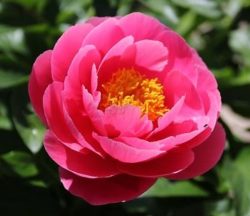
Semi-Double
Quite a range of variations are included in this designation. They have in common prominent stamens, and a bulking of the petalage, through combinations of traits: partial transformation of stamens into inner petals, multiplication of petals, or petals structure which add visual bulk to the flower.
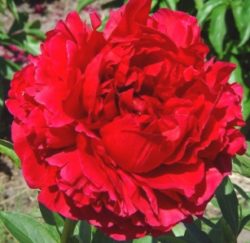
Full Double
In the ultimate expression of this form, all stamens and carpels are transformed into petals. Nevertheless stamens are allowed, provided they are obscure, can scarcely be seen or not at all, without manually separating petals. Peony cultivars of this class are almost always of two-stage (flower-in-flower) anatomy, presumably accounting for genesis of the term “Double” in traditional peony dialogue. The two-stage anatomy accounts for the greater amount of petals seen in Full Doubles. When pollen-bearing stamens occur in these flowers they will be found in a thin ring at the margin of the lower flower and in a small tuft embedded at center.
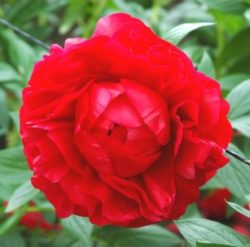
Additional Resources
Growing Herbaceous Peonies
Culture and Care of Herbaceous Peonies
Peonies are among the elite of ornamentals. When well provided for they give increasing rewards for years and will continue to do so indefinitely. Peonies that were planted long ago are often seen flowering around older homes. They also may be seen at abandoned rural house sites and old cemeteries where they continue to flower regularly with no current care. When suitably positioned, peonies planted today will give similar results. See our Additional Resources for further information.
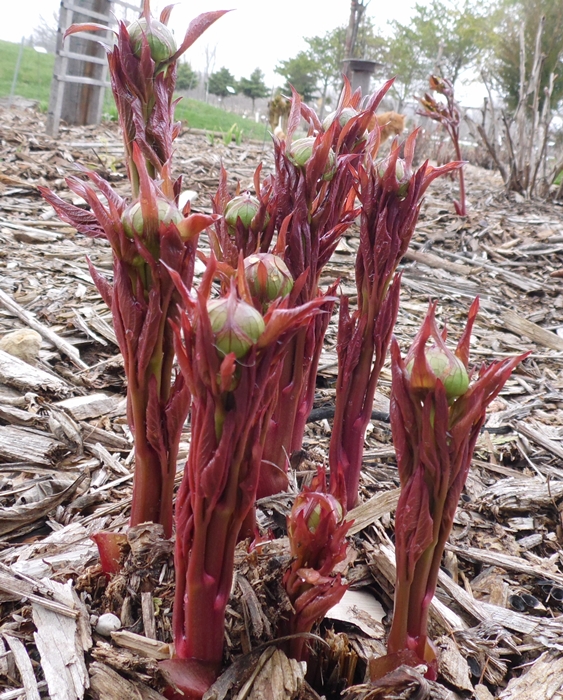
Herbaceous Hybrid ‘Vanilla Schnapps’ in Early Spring

Herbaceous Hybrid ‘Red Charm’
Additional Resources
Propagating Herbaceous Peonies
How to Divide Peonies or Raise Peonies from Seed
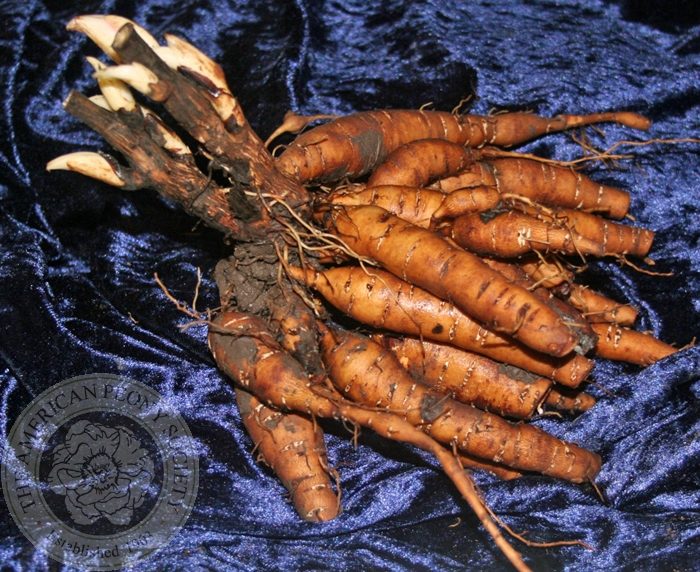
Herbaceous hybrid ‘Alba Plena’ Division
Propagation is the act of increasing the number of plants from a single peony. There comes a time when it’s handy to know how to propagate peonies, whether you want to share a favorite peony plant with a friend, create more divisions of a favorite cut flower, or rescue a classic heritage variety from Grandma’s back yard.
A number of methods can be used to propagate peonies, each has its merits. Some are fairly simple, but some are difficult or complex. All require patience, as peonies are slow growers compared to many other plants. However, peonies require minimal care in most instances and are very long lived, making them an excellent choice for the garden.
The most common method of propagation for herbaceous peonies is crown/root division of plants that are 3 or more years in age. Each cultivar will have its own unique crown structure and a bit of investigation will be required to determine the best areas to cut away to create a division. The goal in making a division is to create a plant that has 3 to 5 eyes on a crown with an adequate root system to support it for a year or two.
Please note that peonies should be divided into divisions when they are dug up. Digging, moving and replanting entire clumps , without division, will cause the plants to go into slow decline. The creation of a division will cause new roots to grow and create a viable and vigorous plant that will be a valuable show piece in the garden for years to come. See Additional Resources below for more detailed instructions about dividing peonies.
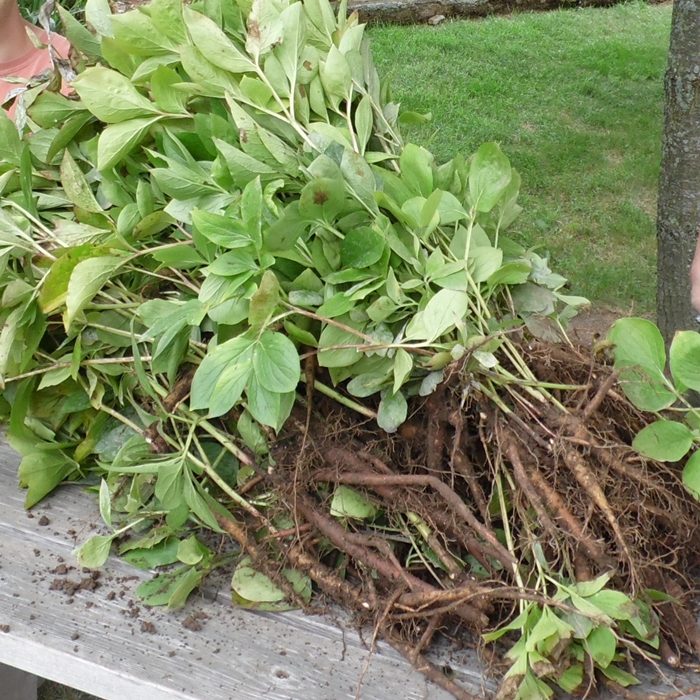
4 Year Old Seed Grown Peonies
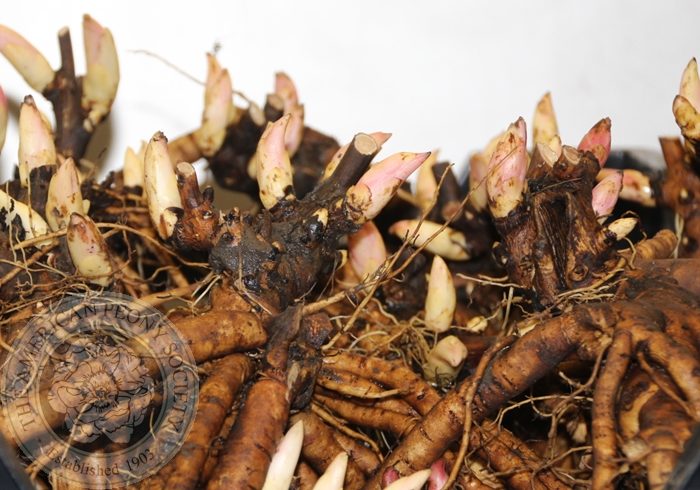
Herbaceous Hybrid ‘Claire de Lune’ Division
